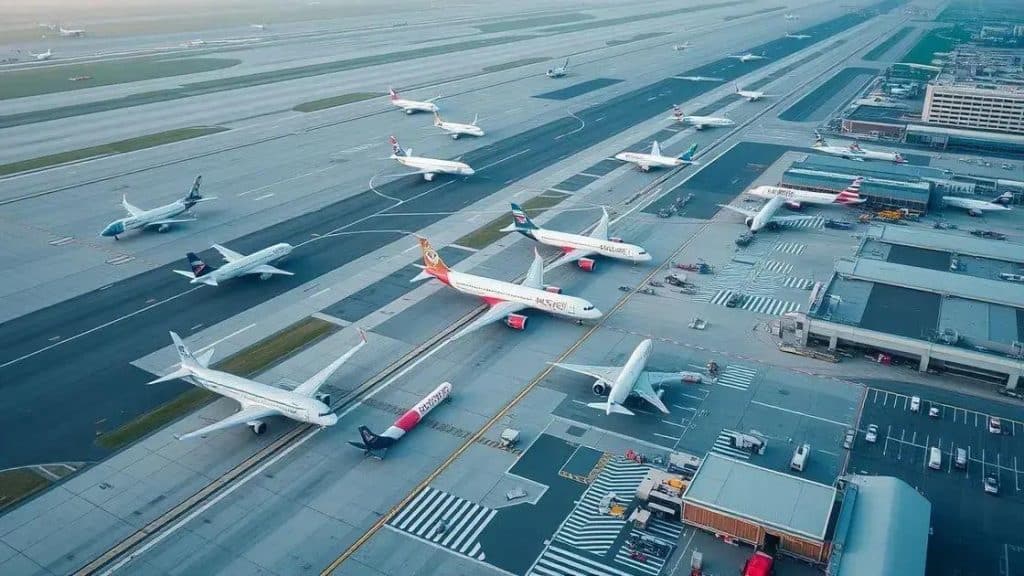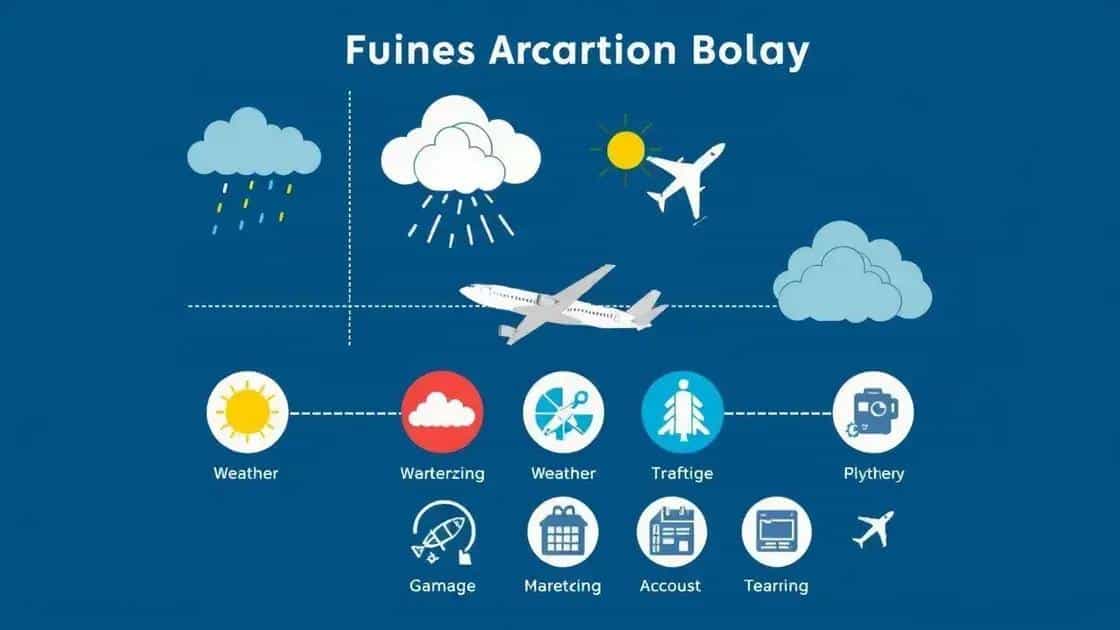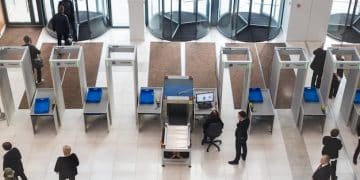Flight delay statistics by US region: what to know

Flight delay statistics by US region reveal that weather, air traffic, and technical issues significantly impact travel, making it crucial for travelers to stay informed and plan accordingly to minimize disruptions.
Flight delay statistics by US region provide valuable insights that can help you choose the best times to travel. Have you ever wondered how delays vary across the country? Understanding these patterns could make a big difference in your travel plans.
Overview of flight delays in the US regions
When it comes to flight delays in the US, understanding the trends across different regions is essential. Each area experiences delays differently, influenced by various factors. Let’s explore how these delays manifest and what you can expect based on your travel plans.
Flight delay trends by region
In the Northeastern US, airports often face delays due to heavy air traffic and adverse weather conditions. For instance, New York City airports are among the busiest, leading to frequent hold-ups. On the other hand, the Western regions experience delays primarily caused by unpredictable weather patterns and natural phenomena, such as wildfires or snowstorms.
Factors affecting delays
Some key factors leading to flight delays across regions include:
- Air traffic congestion: Busy hubs like Los Angeles and Chicago often face higher delay rates due to heavy traffic.
- Weather conditions: Storms, rain, and snow can slow down operations significantly in any region.
- Technical issues: Mechanical problems may cause unexpected delays regardless of the region.
Travelers should be aware that regions like the South often have fewer weather-related delays, making them popular for travel during storm season. However, delays can still occur due to other factors like airport traffic.
Being informed about these regional differences allows travelers to plan better. For instance, if you’re traveling to the Northeast in winter, it’s wise to leave extra time for possible delays. Understanding flight delay statistics empowers you to make smarter travel choices.
Major causes of flight delays by region

Understanding the major causes of flight delays by region helps travelers plan better. Each part of the United States has unique factors that influence how long flights are delayed. Knowing these can make a significant difference.
Weather Conditions
Weather is a leading cause of delays nationwide. In the Northeast, winter storms can quickly lead to cancellations and delays due to snow and ice. Conversely, in the Southwest, summer thunderstorms might cause abrupt flight changes. Each region’s climate plays a critical role in travel disruptions.
Air Traffic Management
High traffic levels contribute to delays, especially at major airports. Airports like JFK in New York and LAX in Los Angeles often face congestion that leads to extended wait times. Air traffic control must manage these busy skies, adding to the complexity of air travel.
Technical Malfunctions
Another significant cause of delays is aircraft maintenance or technical issues. These can affect planes at any time and can result in prolonged ground time while repairs take place. Travelers in all regions should be aware that these unexpected problems can arise.
Finally, regional events such as festivals, conventions, or crises can unexpectedly increase the volume of travelers. This surge in traffic can lead to longer wait times. Understanding these factors gives travelers a clearer view of what to expect when planning a trip.
Impact of weather on flight delays
The impact of weather on flight delays is significant and can affect travel plans unexpectedly. Weather can influence the operation of flights in various ways, leading to cancellations or long wait times.
Types of Weather-Related Delays
Different weather conditions lead to various kinds of delays. For example, heavy snowfall and ice can ground flights in winter, especially in northern regions. In the summer, thunderstorms may cause air traffic to slow down due to safety concerns. Fog is another weather factor that can reduce visibility at airports, leading to further delays.
Regional Weather Effects
Regions are affected by weather differently, resulting in unique delay patterns. The Northeast experiences frequent winter storms, causing widespread travel disruptions. In contrast, the Southeast might face hurricane impacts that lead to preemptive cancellations.
- Winter storms: Snow and ice lead to significant delays in northern states.
- Thunderstorms: These can cause ground stop procedures in the summer.
- Hurricanes: Coastal areas may cancel flights in anticipation of severe weather.
Travelers should be aware of the seasonal weather patterns in their departure and arrival regions. For instance, flying to Florida during hurricane season may increase the chances of encountering flight issues. Keeping an eye on weather forecasts can help in making informed travel decisions and avoiding unexpected delays.
Tips for travelers based on delay statistics

Using delay statistics can help travelers make smarter choices and avoid frustrating situations at the airport. Knowing what to expect can save time and enhance the travel experience.
Plan Ahead
One of the best tips is to always check the flight status before heading to the airport. Many airlines provide real-time updates on delays. This way, you can adjust your plans if necessary.
Choose Flights Wisely
Selecting your flight carefully can make a significant difference. For instance, morning flights often have fewer delays because air traffic is lighter compared to afternoon and evening flights. Consider booking flights earlier in the day whenever possible.
- Traveling off-peak: Avoid managing travel during holidays or busy seasons.
- Regional trends: Be aware of flight patterns in your specific area.
- Flexible tickets: Opt for tickets that allow changes without hefty fees.
By being informed about typical delay times for your route, you can anticipate issues more effectively. For instance, if you know that certain airlines or airports frequently have delays, it might be worth looking into alternatives. Keeping these factors in mind can make your travels smoother.
Utilizing apps and online resources to monitor weather conditions at both the departure and arrival airports will also aid in preparation. The blend of statistics and careful planning can greatly enhance your travel experience.
FAQ – Frequently Asked Questions about Flight Delays and Travel Tips
What are common causes of flight delays?
Flight delays are often caused by weather conditions, air traffic congestion, technical issues, and regional events such as holidays or conventions.
How can I check the status of my flight before traveling?
You can check your flight status directly on the airline’s website or through their mobile app for real-time updates.
Is it better to fly in the morning or evening to avoid delays?
Flying in the morning is generally better as there tend to be fewer delays during this time compared to afternoon or evening flights.
What should I do if my flight is delayed?
If your flight is delayed, stay informed by monitoring updates, reach out to your airline for options, and consider using travel apps to assist with rebooking or adjusting your plans.





